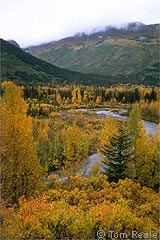Alaska Weekend Getaway
 For a state that’s more than twice the size of Texas and known the world over for its wilderness, Alaska has surprisingly few marked and maintained hiking trails. The vast majority of the state’s famed wildlands are far from its rudimentary road system and accessible only by boat or plane. And while the opportunities for escaping the crowds by chartering a plane or boat are many, it’s an expensive way to travel. Also, being completely removed from the comforts and comparative safety of civilization isn’t everyone’s cup of tea. Flying into a truly remote region and standing on untamed ground, watching your last link to society take off and disappear over the horizon, is not an adventure for the unprepared.
For a state that’s more than twice the size of Texas and known the world over for its wilderness, Alaska has surprisingly few marked and maintained hiking trails. The vast majority of the state’s famed wildlands are far from its rudimentary road system and accessible only by boat or plane. And while the opportunities for escaping the crowds by chartering a plane or boat are many, it’s an expensive way to travel. Also, being completely removed from the comforts and comparative safety of civilization isn’t everyone’s cup of tea. Flying into a truly remote region and standing on untamed ground, watching your last link to society take off and disappear over the horizon, is not an adventure for the unprepared.
However, if you want to sample Alaskan wilderness without the trouble and expense of a fly-in trip, the Resurrection Pass Trail is for you. The trail slices through the Kenai Mountains near Anchorage, offering a 38-mile-long, all-season route through some truly stunning scenery. Access to tundra areas above tree line is relatively easy, there’s plenty of wildlife to see if you take the time and effort to look, and if you want to soften your backcountry experience just a little, there’s a string of U.S. Forest Service cabins available for use. These humble retreats offer respite from foul weather in the summer and a warm, heated spot for skiers in the winter.
The northern trailhead is 20 miles from the Seward Highway and four miles south of the village of Hope on Resurrection Creek Road. The southern trailhead lies on the Sterling Highway, near the town of Cooper Landing — just 53 miles east of Soldotna and 106 miles south of Anchorage. The trail is well marked and maintained, but you won’t find elaborate map displays at trail junctions with explicit directions and clearly marked”You Are Here” notations. After all, it is Alaska, and a certain level of competence and self-reliance is assumed.
The area is neither a wilderness area nor a national park. Snowmobiles (or snow machines, in the local parlance) are permitted on the trail for most of the winter, horses are allowed after spring breakup, and the area is open to hunting. If the sight of a disassembled moose or caribou offends you, avoid the big game season from August 10 through the end of September.
The trail is open year-round, but some seasonal caveats are in order. The high country is likely to hold snow well into June in some years, so spring travelers are advised to carry snowshoes or else count on untold hours of exhausting postholing. Once the snow is gone, expect muddy trails, especially on the Devil’s Pass spur.
If you try a cross-country ski trip, be advised that the area is open to smow machines from November until mid-February. Avoiding the snow-machine season has two advantages. For one, you’ll have a quieter experience, and after the snow-machine season is over, the Forest Service provides wood to the cabins. This is a major advantage, since finding and cutting firewood is time- and labor-intensive.
Article Contributor:Tom Reale

Leave a Comment